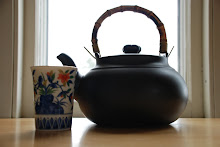
With perhaps one of the last snowfall of the season and its attendant powdery patina still on the ground, E and I ushered in spring with our cups of the sakura-cha, a tisane made from salted cherry blossoms. This was the first tea served at a recent tea-tasting at our favorite local Japanese restaurant, Nanakusa.

Under the stern eyes of Hello Kitty -militaristically imposing in her bearing- our group of tea enthusiasts gathered around our hosts, Richard and Yoko, as they offered us cups of the sakura-cha. I held the delicate teacup in my hands and gazed at the lone cherry blossom reposing on the bottom of the cup and marveled at this study in fragile beauty.

Carrying forward the briny motif, our hosts next served the kobucha, a tisane made from the kelp seaweed. Its savory nature had me conjuring up a steamy bowl of miso soup to accompany tamari-flavored rice crackers.

My mind, started on its trajectory of musings on savories, it was only natural that the tea which came next was the soba-cha, roasted buckwheat steeped in boiled water. Its taste was one of nutty toastiness.

After we had lingered on the three tisanal amuse-bouches, we were ready for the tasting of green teas. The green teas served were bancha, kukicha, genmaicha, hojicha, sencha, gyokuro, and matcha- these words were like a tripping waterfall splashing over pebbles.
The higashi, a soft sweet candy served with matcha, melted in my mouth as I gratefully received the bowl of matcha into my hands. Its familiar brothiness was soothing and bracing. With its warmth suffusing me, E and I thanked our gracious hostess for a wonderful evening and we were soon enveloped in a clear moonlit night.



























 hot version of the cryptically named Hong Kong styled tea. Plumbing the matter a bit with searching questions of our friendly waitress, I gathered that this was bubble tea.
hot version of the cryptically named Hong Kong styled tea. Plumbing the matter a bit with searching questions of our friendly waitress, I gathered that this was bubble tea. 










